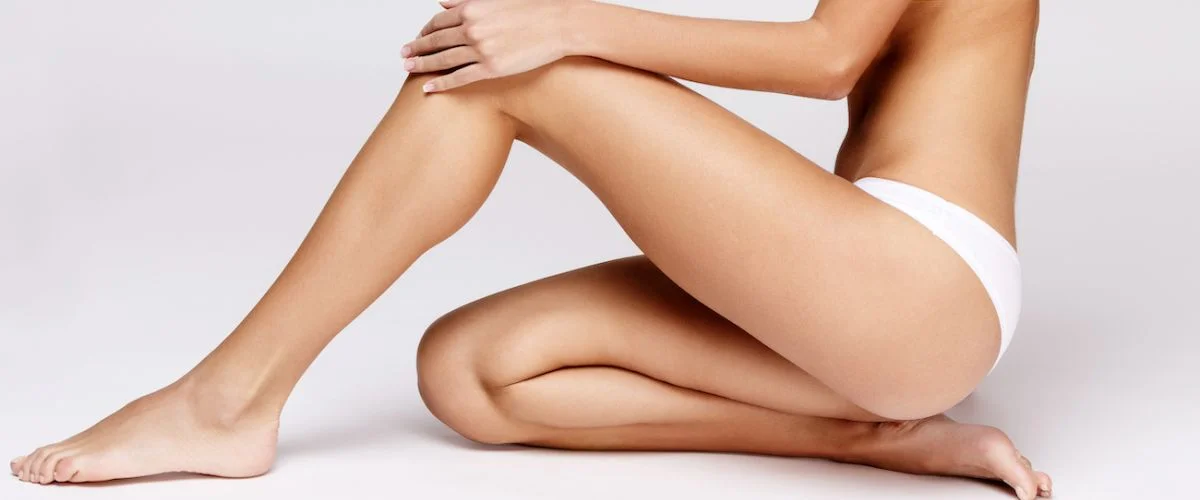Thigh lift surgery (Thighplasty), is the surgical procedure to remove loose skin and excess fat from the upper inner thighs which improve the appearance and gives your thigh a ‘more toned’ appearance. During the surgery, an incision is made high up on the thigh, near the outer waist, and can be concealed in the underwear. A thigh lift procedure is a good choice for those struggling to achieve their body goals with weight control and who want a firmer, more youthful-looking body. Thigh Lift is among the top 10 cosmetic treatments in Iran, to read the full list click here…
What is a Thigh Lift?
A thigh lift, also known as thighplasty, is a surgical procedure that aims to reshape the thighs by reducing excess skin and fat, resulting in smoother skin and better-proportioned contours of the thighs and lower body. This procedure is often performed on individuals who have loose, sagging skin on their thighs due to significant weight loss, aging, or other factors.
A thigh lift is not a solution for removing excess fat. In cases where skin elasticity is good, liposuction alone can remove excess fat and improve the thigh’s appearance. However, when skin elasticity is poor, a combination of liposuction and thigh lift techniques may be recommended.
Recovery from a thigh lift involves some swelling and discomfort, which can be managed with medication. A compression garment may need to be worn to minimize swelling and support the new contours of the thighs as they heal. Most patients can return to work and normal activities within a few weeks, but strenuous exercise should be avoided for at least a month or two.
It’s important to note that a thigh lift leaves scars, although they are usually well concealed within the body’s natural contours. Despite this, the results are typically long-lasting, provided that the patient maintains a stable weight and general fitness.
Who is a candidate for a thigh lift?
Those with relatively stable weight
Individuals with excess soft tissue along the inner thigh region
Healthy individuals without complicating medical conditions
Non-smokers
Individuals with a positive outlook and realistic goals for what thigh lift surgery can accomplish
Individuals committed to leading a healthy lifestyle including proper nutrition and fitness

Who needs a thigh lift?
For those with loose, flabby skin on their thighs who are tired of trying diets and exercise with no result, a thigh lift may be a great option. A thigh lift helps those who:
Had bariatric surgery or massive weight loss
Have unwanted loose, flabby skin on your thighs
Aging has led to sagging, cellulite, and loose skin on your thighs
Clothes do not fit properly because of your heavy thighs
Some of the benefits of a thigh lift include:
Remove excess fat or skin from your thighs
Tighten loose and sagging skin on your thighs
Get firmer and more youthful-looking thighs
Achieve a shapelier and more proportional body
Look better in clothes
Improve your self-image and self-confidence
How should I prepare for a Thigh Lift procedure?
Preparing for a thigh lift procedure involves several steps to ensure the best possible outcome. First and foremost, it’s crucial to have a detailed consultation with your plastic surgeon. During this meeting, you should discuss your goals, expectations, and any concerns you may have. The surgeon will evaluate your health status, discuss the surgical options available, and explain the likely outcomes and potential risks.
Once you’ve decided to proceed with the surgery, there are several things you can do to prepare. If you smoke, you’ll need to stop at least six weeks before the surgery, as smoking can interfere with the healing process. You should also avoid taking aspirin, anti-inflammatory drugs, and herbal supplements, as they can increase bleeding.
A healthy diet and regular exercise can help improve your overall health and enhance your body’s ability to recover. However, you should avoid any drastic diet changes or weight loss immediately before the surgery, as this can affect the surgical plan.
You’ll also need to arrange for someone to drive you home after the surgery and stay with you for the first night. It’s a good idea to prepare your home for your recovery period by setting up a comfortable place to rest and making sure necessary items are within easy reach.
Your surgeon may provide specific instructions on how to prepare for the surgery, including guidelines on eating and drinking, cleaning your skin, and what to bring with you to the hospital. It’s important to follow these instructions carefully.
What are the different types of thigh lifts?
Thigh lift surgery is used to remove excess skin and fat, though different types use different incisions. To choose the best surgery for your needs, talk to your surgeon, the different thigh lift types include:
Inner (medial) thigh lift: The most common form, addressing the sagging skin of the inner thigh via an incision from your groin down toward your knee or toward the back of your thigh area.
Mini thigh lift: Fewer incisions than other types, only involving an incision in your groin area.
Outer (bilateral) thigh lift: Addressing the outer thigh, an incision that starts in your groin area, and then extends outward to your hip and lower back area.
Vertical thigh lift: Addressing excess skin in all areas of the thigh, larger incisions that extend down to your knees. Due to a higher risk for complications, it may not be recommended to you.
Lift with liposuction: If the thigh area has poor skin elasticity, liposuction may be added to thigh lift surgery to help remove excess fat cells and prevent sagging skin.

What happens during a thigh lift?
A thigh lift procedure takes 2-3 hours, depending on the amount of excess skin and tissue on your thighs. Prior to beginning, your surgeon will make markings to plan the intended incisions. For most patients, the incisions are made on your inner leg crease to minimize visibility. After the excess tissue has been removed, the skin will be rewrapped. The recovery after a thigh lift surgery takes about 6 weeks. Tape and compression garments will likely be worn in 3-4 weeks. As your surgeon may advise walking 1 day after surgery, light exercise may also be incorporated into your routine after 2 weeks.
Where will I have Thigh Lift scars?
A thigh lift is a surgical procedure designed to reshape the thighs by removing excess skin and fat. As with any surgical procedure, it will result in some degree of scarring. The location and extent of these scars depend largely on the specific type of thigh lift performed.
In a medial (inner) thigh lift, the incision is usually made in the groin area, extending downward and wrapping around the back of the thigh. If more substantial amounts of fat or skin need to be removed, the incision may extend down to the knee. The resulting scars are generally hidden in the body’s natural contours, although they may be visible when the legs are parted or when wearing high-cut clothing or swimwear.
In a lateral (outer) thigh lift, the incision is typically made extending from the groin around the hip. This procedure may leave a scar that is visible when wearing low-cut clothing or swimwear.
In a spiral thigh lift, the incision is made at the buttock fold and continues around the groin crease at the junction of the thigh and pubic area. This technique allows for lifting of the front, back, inner, and outer thigh. The scar is well concealed within the body’s natural contours.
It’s important to note that the appearance of scars can vary based on several factors, including your body’s healing process, the specific surgical technique used, and post-operative care. Over time, these scars will fade and become less noticeable.
What are the benefits of a Thigh Lift?
Improvement in body contours: By removing excess skin and fat, a thigh lift can give the thighs a more toned and proportionate appearance. This can make the body look more balanced and can improve the fit and look of clothing and swimwear.
Reduction of discomfort (caused by excess skin): For some individuals, excess skin on the thighs can lead to chafing, rashes, and irritation, particularly during physical activities. By removing this excess skin, a thigh lift can alleviate these symptoms, making movement more comfortable.
Improved self-esteem & Body Image: Many individuals who undergo a thigh lift have struggled with the appearance of their thighs for a long time. Seeing the transformation after the surgery can provide a significant psychological boost.
Long-lasting Results: While the aging process will continue, most patients enjoy the results of their thigh lifts for many years. Maintaining a stable weight and healthy lifestyle can help prolong the results.
It’s important to note that while a thigh lift has many benefits, it’s a major surgery that comes with its own risks and recovery period. Therefore, it’s crucial to have a thorough discussion with a qualified plastic surgeon before deciding to proceed. They can provide detailed information about the procedure, recovery, and potential risks and complications, helping you make an informed decision.
What are the risks of thigh lift surgery?
Before committing to a thigh lift, you’ll need to determine whether the results you’re looking to achieve are worth the risk of side effects. Your risk for complications may increase if you smoke, have limited physical activity, or consume a diet high in processed foods. Thigh lift surgery risks include:
Unfavorable scarring
Bleeding (hematoma)
Infection
Fluid accumulation
Poor wound healing
Skin loss
Blood clots
Numbness or other changes in skin sensation
Anesthesia risks
Skin discoloration and/or swelling
Fatty tissue found deep in the skin might die (fat necrosis)
Major wound separation
Asymmetry
Pain, which may persist
Highly visible surgical scar location, unacceptable visible deformities, bunching and rippling in the skin near the suture lines or at the ends of the incisions
Deep vein thrombosis, cardiac and pulmonary complications
Recurrent looseness of skin
Sutures may spontaneously surface through the skin, become visible, or produce irritation that requires removal
Possibility of revisional surgery

Thigh lift recovery?
You will be sent home with dressings placed against the incision to help ease swelling. A tube may also be inserted to help drain excess blood and fluids from the area. You’ll need to make a follow-up appointment to have your surgeon remove these items. As with any major surgery, patients will need to take time off work to recover. It’s normal to experience pain, bruising, and swelling for a few days after the procedure. Although more contour on the thighs can be noticed right away, the full results won’t be visible for several months.
Conclusion
In conclusion, thigh lift, or thighplasty, is a surgical procedure that aims to improve the contour and appearance of the thighs. It is often sought after by individuals who have excess skin and fat in the thigh area due to significant weight loss, aging, or other factors. The procedure involves the removal of this excess skin and fat, resulting in smoother skin and better-proportioned thighs. While it comes with the inevitable trade-off of scarring, the benefits of improved body contours, reduced discomfort, and enhanced self-esteem often outweigh this drawback for many patients. As with any surgical procedure, it’s crucial to have a thorough discussion with a qualified plastic surgeon before deciding to proceed.